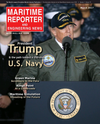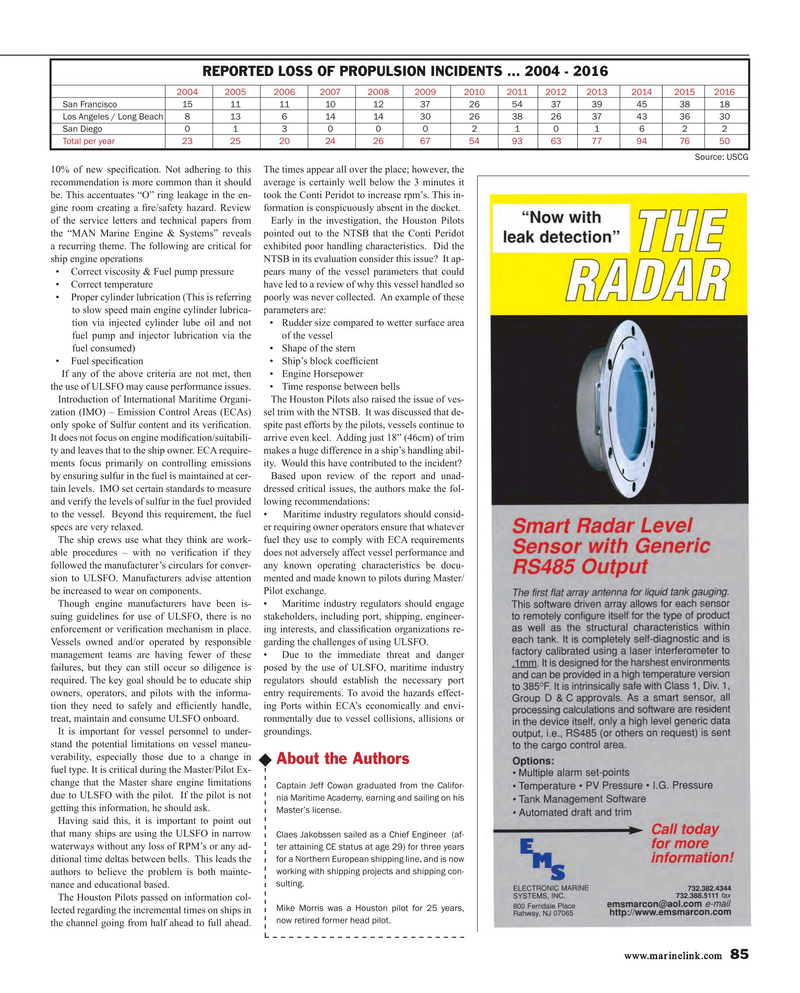
Page 85: of Maritime Reporter Magazine (March 2017)
U.S. Navy Quarterly & Maritime Simulation Technologies
Read this page in Pdf, Flash or Html5 edition of March 2017 Maritime Reporter Magazine
REPORTED LOSS OF PROPULSION INCIDENTS ... 2004 - 2016 2014 2013 2016 2004 2007 2010 2005 2008 2011 2006 2009 2012 2015
San Francisco 15 11 11 10 12 37 26 54 37 39 45 38 18
Los Angeles / Long Beach 8 13 6 14 14 30 26 38 26 37 43 36 30
San Diego 0 1 3 0 0 0 2 1 0 1 6 2 2
Total per year 23 25 20 24 26 67 54 93 63 77 94 76 50
Source: USCG 10% of new speci? cation. Not adhering to this The times appear all over the place; however, the recommendation is more common than it should average is certainly well below the 3 minutes it be. This accentuates “O” ring leakage in the en- took the Conti Peridot to increase rpm’s. This in- gine room creating a ? re/safety hazard. Review formation is conspicuously absent in the docket.
of the service letters and technical papers from Early in the investigation, the Houston Pilots the “MAN Marine Engine & Systems” reveals pointed out to the NTSB that the Conti Peridot a recurring theme. The following are critical for exhibited poor handling characteristics. Did the ship engine operations NTSB in its evaluation consider this issue? It ap- • Correct viscosity & Fuel pump pressure pears many of the vessel parameters that could • Correct temperature have led to a review of why this vessel handled so • Proper cylinder lubrication (This is referring poorly was never collected. An example of these to slow speed main engine cylinder lubrica- parameters are: tion via injected cylinder lube oil and not • Rudder size compared to wetter surface area fuel pump and injector lubrication via the of the vessel fuel consumed) • Shape of the stern • Fuel speci? cation • Ship’s block coef? cient If any of the above criteria are not met, then • Engine Horsepower the use of ULSFO may cause performance issues. • Time response between bells
Introduction of International Maritime Organi- The Houston Pilots also raised the issue of ves- zation (IMO) – Emission Control Areas (ECAs) sel trim with the NTSB. It was discussed that de- only spoke of Sulfur content and its veri? cation. spite past efforts by the pilots, vessels continue to
It does not focus on engine modi? cation/suitabili- arrive even keel. Adding just 18” (46cm) of trim ty and leaves that to the ship owner. ECA require- makes a huge difference in a ship’s handling abil- ments focus primarily on controlling emissions ity. Would this have contributed to the incident?
by ensuring sulfur in the fuel is maintained at cer- Based upon review of the report and unad- tain levels. IMO set certain standards to measure dressed critical issues, the authors make the fol- and verify the levels of sulfur in the fuel provided lowing recommendations: to the vessel. Beyond this requirement, the fuel • Maritime industry regulators should consid- specs are very relaxed. er requiring owner operators ensure that whatever
The ship crews use what they think are work- fuel they use to comply with ECA requirements able procedures – with no veri? cation if they does not adversely affect vessel performance and followed the manufacturer’s circulars for conver- any known operating characteristics be docu- sion to ULSFO. Manufacturers advise attention mented and made known to pilots during Master/ be increased to wear on components. Pilot exchange.
Though engine manufacturers have been is- • Maritime industry regulators should engage suing guidelines for use of ULSFO, there is no stakeholders, including port, shipping, engineer- enforcement or veri? cation mechanism in place. ing interests, and classi? cation organizations re-
Vessels owned and/or operated by responsible garding the challenges of using ULSFO. management teams are having fewer of these • Due to the immediate threat and danger failures, but they can still occur so diligence is posed by the use of ULSFO, maritime industry required. The key goal should be to educate ship regulators should establish the necessary port owners, operators, and pilots with the informa- entry requirements. To avoid the hazards effect- tion they need to safely and ef? ciently handle, ing Ports within ECA’s economically and envi- treat, maintain and consume ULSFO onboard. ronmentally due to vessel collisions, allisions or
It is important for vessel personnel to under- groundings.
stand the potential limitations on vessel maneu- verability, especially those due to a change in
About the Authors fuel type. It is critical during the Master/Pilot Ex- change that the Master share engine limitations
Captain Jeff Cowan graduated from the Califor- due to ULSFO with the pilot. If the pilot is not nia Maritime Academy, earning and sailing on his getting this information, he should ask.
Master’s license.
Having said this, it is important to point out that many ships are using the ULSFO in narrow
Claes Jakobssen sailed as a Chief Engineer (af- waterways without any loss of RPM’s or any ad- ter attaining CE status at age 29) for three years for a Northern European shipping line, and is now ditional time deltas between bells. This leads the working with shipping projects and shipping con- authors to believe the problem is both mainte- sulting.
nance and educational based.
The Houston Pilots passed on information col-
Mike Morris was a Houston pilot for 25 years, lected regarding the incremental times on ships in now retired former head pilot.
the channel going from half ahead to full ahead. www.marinelink.com 85
MR #3 (82-89).indd 85 MR #3 (82-89).indd 85 3/7/2017 5:44:16 PM3/7/2017 5:44:16 PM

 84
84

 86
86
